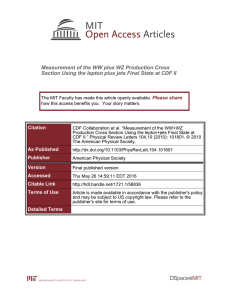Observation of Electroweak Single Top-Quark Production Please share
advertisement
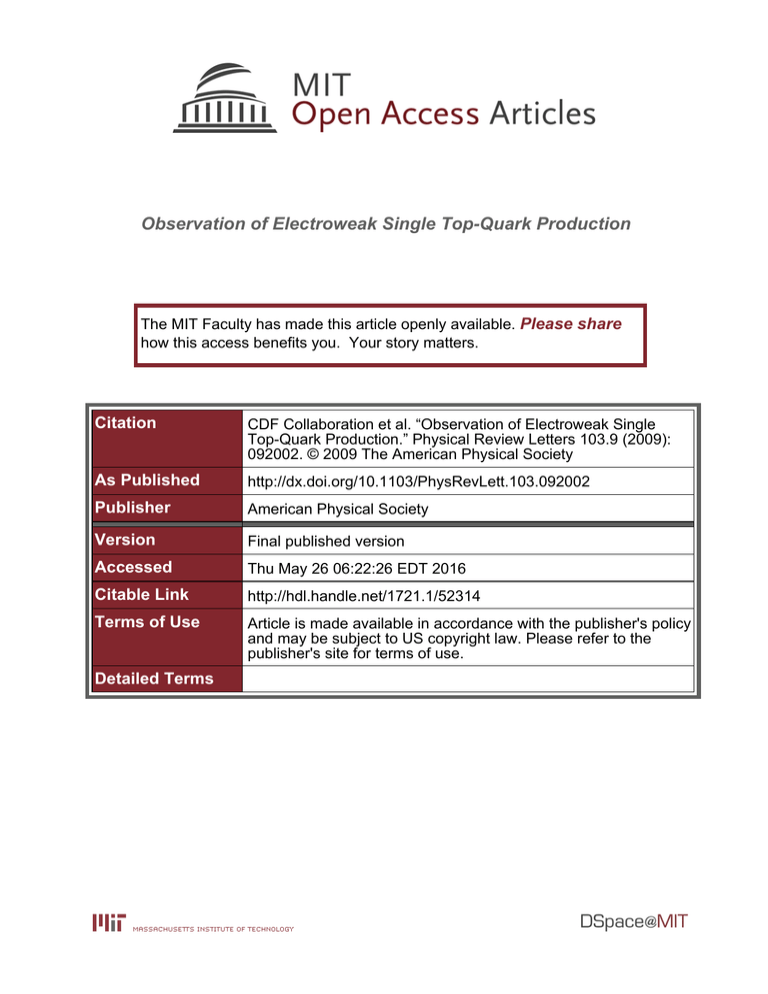
Observation of Electroweak Single Top-Quark Production The MIT Faculty has made this article openly available. Please share how this access benefits you. Your story matters. Citation CDF Collaboration et al. “Observation of Electroweak Single Top-Quark Production.” Physical Review Letters 103.9 (2009): 092002. © 2009 The American Physical Society As Published http://dx.doi.org/10.1103/PhysRevLett.103.092002 Publisher American Physical Society Version Final published version Accessed Thu May 26 06:22:26 EDT 2016 Citable Link http://hdl.handle.net/1721.1/52314 Terms of Use Article is made available in accordance with the publisher's policy and may be subject to US copyright law. Please refer to the publisher's site for terms of use. Detailed Terms PRL 103, 092002 (2009) PHYSICAL REVIEW LETTERS week ending 28 AUGUST 2009 Observation of Electroweak Single Top-Quark Production T. Aaltonen,24 J. Adelman,14 T. Akimoto,56 B. Álvarez González,12,t S. Amerio,44b,44a D. Amidei,35 A. Anastassov,39 A. Annovi,20 J. Antos,15 G. Apollinari,18 A. Apresyan,49 T. Arisawa,58 A. Artikov,16 W. Ashmanskas,18 A. Attal,4 A. Aurisano,54 F. Azfar,43 W. Badgett,18 A. Barbaro-Galtieri,29 V. E. Barnes,49 B. A. Barnett,26 P. Barria,47c,47a V. Bartsch,31 G. Bauer,33 P.-H. Beauchemin,34 F. Bedeschi,47a D. Beecher,31 S. Behari,26 G. Bellettini,47b,47a J. Bellinger,60 D. Benjamin,17 A. Beretvas,18 J. Beringer,29 A. Bhatti,51 M. Binkley,18 D. Bisello,44b,44a I. Bizjak,31,y R. E. Blair,2 C. Blocker,7 B. Blumenfeld,26 A. Bocci,17 A. Bodek,50 V. Boisvert,50 G. Bolla,49 D. Bortoletto,49 J. Boudreau,48 A. Boveia,11 B. Brau,11,b A. Bridgeman,25 L. Brigliadori,6b,6a C. Bromberg,36 E. Brubaker,14 J. Budagov,16 H. S. Budd,50 S. Budd,25 S. Burke,18 K. Burkett,18 G. Busetto,44b,44a P. Bussey,22 A. Buzatu,34 K. L. Byrum,2 S. Cabrera,17,v C. Calancha,32 M. Campanelli,36 M. Campbell,35 F. Canelli,14,18 A. Canepa,46 B. Carls,25 D. Carlsmith,60 R. Carosi,47a S. Carrillo,19,o S. Carron,34 B. Casal,12 M. Casarsa,18 A. Castro,6b,6a P. Catastini,47c,47a D. Cauz,55b,55a V. Cavaliere,47c,47a M. Cavalli-Sforza,4 A. Cerri,29 L. Cerrito,31,p S. H. Chang,28 Y. C. Chen,1 M. Chertok,8 G. Chiarelli,47a G. Chlachidze,18 F. Chlebana,18 K. Cho,28 D. Chokheli,16 J. P. Chou,23 G. Choudalakis,33 S. H. Chuang,53 K. Chung,13 W. H. Chung,60 Y. S. Chung,50 T. Chwalek,27 C. I. Ciobanu,45 M. A. Ciocci,47c,47a A. Clark,21 D. Clark,7 G. Compostella,44a M. E. Convery,18 J. Conway,8 M. Cordelli,20 G. Cortiana,44b,44a C. A. Cox,8 D. J. Cox,8 F. Crescioli,47b,47a C. Cuenca Almenar,8,v J. Cuevas,12,t R. Culbertson,18 J. C. Cully,35 D. Dagenhart,18 M. Datta,18 T. Davies,22 P. de Barbaro,50 S. De Cecco,52a A. Deisher,29 G. De Lorenzo,4 M. Dell’Orso,47b,47a C. Deluca,4 L. Demortier,51 J. Deng,17 M. Deninno,6a P. F. Derwent,18 P. Di Canto,47b,47a G. P. di Giovanni,45 C. Dionisi,52b,52a B. Di Ruzza,55b,55a J. R. Dittmann,5 M. D’Onofrio,4 S. Donati,47b,47a P. Dong,9 J. Donini,44a T. Dorigo,44a S. Dube,53 J. Efron,40 A. Elagin,54 R. Erbacher,8 D. Errede,25 S. Errede,25 R. Eusebi,18 H. C. Fang,29 S. Farrington,43 W. T. Fedorko,14 R. G. Feild,61 M. Feindt,27 J. P. Fernandez,32 C. Ferrazza,47d,47a R. Field,19 G. Flanagan,49 R. Forrest,8 M. J. Frank,5 M. Franklin,23 J. C. Freeman,18 I. Furic,19 M. Gallinaro,52a J. Galyardt,13 F. Garberson,11 J. E. Garcia,21 A. F. Garfinkel,49 P. Garosi,47c,47a K. Genser,18 H. Gerberich,25 D. Gerdes,35 A. Gessler,27 S. Giagu,52b,52a V. Giakoumopoulou,3 P. Giannetti,47a K. Gibson,48 J. L. Gimmell,50 C. M. Ginsburg,18 N. Giokaris,3 M. Giordani,55b,55a P. Giromini,20 M. Giunta,47a G. Giurgiu,26 V. Glagolev,16 D. Glenzinski,18 M. Gold,38 N. Goldschmidt,19 A. Golossanov,18 G. Gomez,12 G. Gomez-Ceballos,33 M. Goncharov,33 O. González,32 I. Gorelov,38 A. T. Goshaw,17 K. Goulianos,51 A. Gresele,44b,44a S. Grinstein,23 C. Grosso-Pilcher,14 R. C. Group,18 U. Grundler,25 J. Guimaraes da Costa,23 Z. Gunay-Unalan,36 C. Haber,29 K. Hahn,33 S. R. Hahn,18 E. Halkiadakis,53 B.-Y. Han,50 J. Y. Han,50 F. Happacher,20 K. Hara,56 D. Hare,53 M. Hare,57 S. Harper,43 R. F. Harr,59 R. M. Harris,18 M. Hartz,48 K. Hatakeyama,51 C. Hays,43 M. Heck,27 A. Heijboer,46 J. Heinrich,46 C. Henderson,33 M. Herndon,60 J. Heuser,27 S. Hewamanage,5 D. Hidas,17 C. S. Hill,11,d D. Hirschbuehl,27 A. Hocker,18 S. Hou,1 M. Houlden,30 S.-C. Hsu,29 B. T. Huffman,43 R. E. Hughes,40 U. Husemann,61 M. Hussein,36 J. Huston,36 J. Incandela,11 G. Introzzi,47a M. Iori,52b,52a A. Ivanov,8 E. James,18 D. Jang,13 B. Jayatilaka,17 E. J. Jeon,28 M. K. Jha,6a S. Jindariani,18 W. Johnson,8 M. Jones,49 K. K. Joo,28 S. Y. Jun,13 J. E. Jung,28 T. R. Junk,18 T. Kamon,54 D. Kar,19 P. E. Karchin,59 Y. Kato,42,m R. Kephart,18 J. Keung,46 V. Khotilovich,54 B. Kilminster,18 D. H. Kim,28 H. S. Kim,28 H. W. Kim,28 J. E. Kim,28 M. J. Kim,20 S. B. Kim,28 S. H. Kim,56 Y. K. Kim,14 N. Kimura,56 L. Kirsch,7 S. Klimenko,19 B. Knuteson,33 B. R. Ko,17 K. Kondo,58 D. J. Kong,28 J. Konigsberg,19 A. Korytov,19 A. V. Kotwal,17 M. Kreps,27 J. Kroll,46 D. Krop,14 N. Krumnack,5 M. Kruse,17 V. Krutelyov,11 T. Kubo,56 T. Kuhr,27 N. P. Kulkarni,59 M. Kurata,56 S. Kwang,14 A. T. Laasanen,49 S. Lami,47a S. Lammel,18 M. Lancaster,31 R. L. Lander,8 K. Lannon,40,s A. Lath,53 G. Latino,47c,47a I. Lazzizzera,44b,44a T. LeCompte,2 E. Lee,54 H. S. Lee,14 S. W. Lee,54,u S. Leone,47a J. D. Lewis,18 C.-S. Lin,29 J. Linacre,43 M. Lindgren,18 E. Lipeles,46 T. M. Liss,25 A. Lister,8 D. O. Litvintsev,18 C. Liu,48 T. Liu,18 N. S. Lockyer,46 A. Loginov,61 M. Loreti,44b,44a L. Lovas,15 D. Lucchesi,44b,44a C. Luci,52b,52a J. Lueck,27 P. Lujan,29 P. Lukens,18 G. Lungu,51 L. Lyons,43 J. Lys,29 R. Lysak,15 D. MacQueen,34 R. Madrak,18 K. Maeshima,18 K. Makhoul,33 T. Maki,24 P. Maksimovic,26 S. Malde,43 S. Malik,31 G. Manca,30,f A. Manousakis-Katsikakis,3 F. Margaroli,49 C. Marino,27 C. P. Marino,25 A. Martin,61 V. Martin,22,l M. Martı́nez,4 R. Martı́nez-Balları́n,32 T. Maruyama,56 P. Mastrandrea,52a T. Masubuchi,56 M. Mathis,26 M. E. Mattson,59 P. Mazzanti,6a K. S. McFarland,50 P. McIntyre,54 R. McNulty,30,k A. Mehta,30 P. Mehtala,24 A. Menzione,47a P. Merkel,49 C. Mesropian,51 T. Miao,18 N. Miladinovic,7 R. Miller,36 C. Mills,23 M. Milnik,27 A. Mitra,1 G. Mitselmakher,19 H. Miyake,56 N. Moggi,6a C. S. Moon,28 R. Moore,18 M. J. Morello,47a J. Morlock,27 P. Movilla Fernandez,18 J. Mülmenstädt,29 A. Mukherjee,18 Th. Muller,27 R. Mumford,26 P. Murat,18 M. Mussini,6b,6a J. Nachtman,18 Y. Nagai,56 A. Nagano,56 J. Naganoma,56 K. Nakamura,56 I. Nakano,41 A. Napier,57 V. Necula,17 J. Nett,60 0031-9007=09=103(9)=092002(8) 092002-1 Ó 2009 The American Physical Society PRL 103, 092002 (2009) PHYSICAL REVIEW LETTERS week ending 28 AUGUST 2009 C. Neu,46,w M. S. Neubauer,25 S. Neubauer,27 J. Nielsen,29,h L. Nodulman,2 M. Norman,10 O. Norniella,25 E. Nurse,31 L. Oakes,43 S. H. Oh,17 Y. D. Oh,28 I. Oksuzian,19 T. Okusawa,42 R. Orava,24 K. Osterberg,24 S. Pagan Griso,44b,44a E. Palencia,18 V. Papadimitriou,18 A. Papaikonomou,27 A. A. Paramonov,14 B. Parks,40 S. Pashapour,34 J. Patrick,18 G. Pauletta,55b,55a M. Paulini,13 C. Paus,33 T. Peiffer,27 D. E. Pellett,8 A. Penzo,55a T. J. Phillips,17 G. Piacentino,47a E. Pianori,46 L. Pinera,19 K. Pitts,25 C. Plager,9 L. Pondrom,60 K. Potamianos,49 O. Poukhov,16,a N. Pounder,43 F. Prakoshyn,16 A. Pronko,18 J. Proudfoot,2 F. Ptohos,18,j E. Pueschel,13 G. Punzi,47b,47a J. Pursley,60 J. Rademacker,43,d A. Rahaman,48 V. Ramakrishnan,60 N. Ranjan,49 I. Redondo,32 P. Renton,43 M. Renz,27 M. Rescigno,52a S. Richter,27 F. Rimondi,6b,6a L. Ristori,47a A. Robson,22 T. Rodrigo,12 T. Rodriguez,46 E. Rogers,25 S. Rolli,57 R. Roser,18 M. Rossi,55a R. Rossin,11 P. Roy,34 A. Ruiz,12 J. Russ,13 V. Rusu,18 B. Rutherford,18 H. Saarikko,24 A. Safonov,54 W. K. Sakumoto,50 O. Saltó,4 L. Santi,55b,55a S. Sarkar,52b,52a L. Sartori,47a K. Sato,18 A. Savoy-Navarro,45 P. Schlabach,18 A. Schmidt,27 E. E. Schmidt,18 M. A. Schmidt,14 M. P. Schmidt,61,a M. Schmitt,39 T. Schwarz,8 L. Scodellaro,12 A. Scribano,47c,47a F. Scuri,47a A. Sedov,49 S. Seidel,38 Y. Seiya,42 A. Semenov,16 L. Sexton-Kennedy,18 F. Sforza,47b,47a A. Sfyrla,25 S. Z. Shalhout,59 T. Shears,30 P. F. Shepard,48 M. Shimojima,56,r S. Shiraishi,14 M. Shochet,14 Y. Shon,60 I. Shreyber,37 P. Sinervo,34 A. Sisakyan,16 A. J. Slaughter,18 J. Slaunwhite,40 K. Sliwa,57 J. R. Smith,8 F. D. Snider,18 R. Snihur,34 A. Soha,8 S. Somalwar,53 V. Sorin,36 J. Spalding,18 T. Spreitzer,34 P. Squillacioti,47c,47a M. Stanitzki,61 R. St. Denis,22 B. Stelzer,34 O. Stelzer-Chilton,34 D. Stentz,39 J. Strologas,38 G. L. Strycker,35 D. Stuart,11 J. S. Suh,28 A. Sukhanov,19 I. Suslov,16 T. Suzuki,56 A. Taffard,25,g R. Takashima,41 Y. Takeuchi,56 R. Tanaka,41 M. Tecchio,35 P. K. Teng,1 K. Terashi,51 J. Thom,18,i A. S. Thompson,22 G. A. Thompson,25 E. Thomson,46 P. Tipton,61 P. Ttito-Guzmán,32 S. Tkaczyk,18 D. Toback,54 S. Tokar,15 K. Tollefson,36 T. Tomura,56 D. Tonelli,18 S. Torre,20 D. Torretta,18 P. Totaro,55b,55a S. Tourneur,45 M. Trovato,47d,47a S.-Y. Tsai,1 Y. Tu,46 N. Turini,47c,47a F. Ukegawa,56 S. Vallecorsa,21 N. van Remortel,24,c A. Varganov,35 E. Vataga,47d,47a F. Vázquez,19,o G. Velev,18 C. Vellidis,3 M. Vidal,32 R. Vidal,18 I. Vila,12 R. Vilar,12 T. Vine,31 M. Vogel,38 I. Volobouev,29,u G. Volpi,47b,47a P. Wagner,46 R. G. Wagner,2 R. L. Wagner,18 W. Wagner,27,x J. Wagner-Kuhr,27 T. Wakisaka,42 R. Wallny,9 S. M. Wang,1 A. Warburton,34 D. Waters,31 M. Weinberger,54 J. Weinelt,27 W. C. Wester III,18 B. Whitehouse,57 D. Whiteson,46,g A. B. Wicklund,2 E. Wicklund,18 S. Wilbur,14 G. Williams,34 H. H. Williams,46 P. Wilson,18 B. L. Winer,40 P. Wittich,18,i S. Wolbers,18 C. Wolfe,14 T. Wright,35 X. Wu,21 F. Würthwein,10 S. Xie,33 A. Yagil,10 K. Yamamoto,42 J. Yamaoka,17 U. K. Yang,14,q Y. C. Yang,28 W. M. Yao,29 G. P. Yeh,18 J. Yoh,18 K. Yorita,58 T. Yoshida,42,n G. B. Yu,50 I. Yu,28 S. S. Yu,18 J. C. Yun,18 L. Zanello,52b,52a A. Zanetti,55a X. Zhang,25 Y. Zheng,9,e and S. Zucchelli6b,6a (CDF Collaboration) 1 Institute of Physics, Academia Sinica, Taipei, Taiwan 11529, Republic of China 2 Argonne National Laboratory, Argonne, Illinois 60439, USA 3 University of Athens, 157 71 Athens, Greece 4 Institut de Fisica d’Altes Energies, Universitat Autonoma de Barcelona, E-08193, Bellaterra (Barcelona), Spain 5 Baylor University, Waco, Texas 76798, USA 6a Istituto Nazionale di Fisica Nucleare Bologna, I-40127 Bologna, Italy 6b University of Bologna, I-40127 Bologna, Italy 7 Brandeis University, Waltham, Massachusetts 02254, USA 8 University of California, Davis, Davis, California 95616, USA 9 University of California, Los Angeles, Los Angeles, California 90024, USA 10 University of California, San Diego, La Jolla, California 92093, USA 11 University of California, Santa Barbara, Santa Barbara, California 93106, USA 12 Instituto de Fisica de Cantabria, CSIC-University of Cantabria, 39005 Santander, Spain 13 Carnegie Mellon University, Pittsburgh, Pennsylvania 15213, USA 14 Enrico Fermi Institute, University of Chicago, Chicago, Illinois 60637, USA 15 Comenius University, 842 48 Bratislava, Slovakia; Institute of Experimental Physics, 040 01 Kosice, Slovakia 16 Joint Institute for Nuclear Research, RU-141980 Dubna, Russia 17 Duke University, Durham, North Carolina 27708, USA 18 Fermi National Accelerator Laboratory, Batavia, Illinois 60510, USA 19 University of Florida, Gainesville, Florida 32611, USA 20 Laboratori Nazionali di Frascati, Istituto Nazionale di Fisica Nucleare, I-00044 Frascati, Italy 21 University of Geneva, CH-1211 Geneva 4, Switzerland 22 Glasgow University, Glasgow G12 8QQ, United Kingdom 23 Harvard University, Cambridge, Massachusetts 02138, USA 092002-2 PRL 103, 092002 (2009) PHYSICAL REVIEW LETTERS 24 week ending 28 AUGUST 2009 Division of High Energy Physics, Department of Physics, University of Helsinki and Helsinki Institute of Physics, FIN-00014, Helsinki, Finland 25 University of Illinois, Urbana, Illinois 61801, USA 26 The Johns Hopkins University, Baltimore, Maryland 21218, USA 27 Institut für Experimentelle Kernphysik, Universität Karlsruhe, 76128 Karlsruhe, Germany 28 Center for High Energy Physics: Kyungpook National University, Daegu 702-701, Korea; Seoul National University, Seoul 151-742, Korea; Sungkyunkwan University, Suwon 440-746, Korea; Korea Institute of Science and Technology Information, Daejeon, 305-806, Korea; Chonnam National University, Gwangju, 500-757, Korea 29 Ernest Orlando Lawrence Berkeley National Laboratory, Berkeley, California 94720, USA 30 University of Liverpool, Liverpool L69 7ZE, United Kingdom 31 University College London, London WC1E 6BT, United Kingdom 32 Centro de Investigaciones Energeticas Medioambientales y Tecnologicas, E-28040 Madrid, Spain 33 Massachusetts Institute of Technology, Cambridge, Massachusetts 02139, USA 34 Institute of Particle Physics: McGill University, Montréal, Québec, Canada H3A 2T8; Simon Fraser University, Burnaby, British Columbia, Canada V5A 1S6; University of Toronto, Toronto, Ontario, Canada M5S 1A7; and TRIUMF, Vancouver, British Columbia, Canada V6T 2A3 35 University of Michigan, Ann Arbor, Michigan 48109, USA 36 Michigan State University, East Lansing, Michigan 48824, USA 37 Institution for Theoretical and Experimental Physics, ITEP, Moscow 117259, Russia 38 University of New Mexico, Albuquerque, New Mexico 87131, USA 39 Northwestern University, Evanston, Illinois 60208, USA 40 The Ohio State University, Columbus, Ohio 43210, USA 41 Okayama University, Okayama 700-8530, Japan 42 Osaka City University, Osaka 588, Japan 43 University of Oxford, Oxford OX1 3RH, United Kingdom 44a Istituto Nazionale di Fisica Nucleare, Sezione di Padova-Trento, I-35131 Padova, Italy 44b University of Padova, I-35131 Padova, Italy 45 LPNHE, Universite Pierre et Marie Curie/IN2P3-CNRS, UMR7585, Paris, F-75252 France 46 University of Pennsylvania, Philadelphia, Pennsylvania 19104, USA 47a Istituto Nazionale di Fisica Nucleare Pisa, I-56127 Pisa, Italy 47b University of Pisa, I-56127 Pisa, Italy 47c University of Siena, I-56127 Pisa, Italy 47d Scuola Normale Superiore, I-56127 Pisa, Italy 48 University of Pittsburgh, Pittsburgh, Pennsylvania 15260, USA 49 Purdue University, West Lafayette, Indiana 47907, USA 50 University of Rochester, Rochester, New York 14627, USA 51 The Rockefeller University, New York, New York 10021, USA 52a Istituto Nazionale di Fisica Nucleare, Sezione di Roma 1, I-00185 Roma, Italy 52b Sapienza Università di Roma, I-00185 Roma, Italy 53 Rutgers University, Piscataway, New Jersey 08855, USA 54 Texas A&M University, College Station, Texas 77843, USA 55a Istituto Nazionale di Fisica Nucleare Trieste/Udine, I-34100 Trieste, and I-33100 Udine, Italy 55b University of Trieste/Udine, I-34100 Trieste, and I-33100 Udine, Italy 56 University of Tsukuba, Tsukuba, Ibaraki 305, Japan 57 Tufts University, Medford, Massachusetts 02155, USA 58 Waseda University, Tokyo 169, Japan 59 Wayne State University, Detroit, Michigan 48201, USA 60 University of Wisconsin, Madison, Wisconsin 53706, USA 61 Yale University, New Haven, Connecticut 06520, USA (Received 4 March 2009; published 24 August 2009) pffiffiffi We report the observation of single top-quark production using 3:2 fb1 of pp collision data with s ¼ 1:96 TeV collected by the Collider Detector at Fermilab. The significance of the observed data is 5.0 standard deviations, and the expected sensitivity for standard model production and decay is in excess of 5.9 standard deviations. Assuming mt ¼ 175 GeV=c2 , we measure a cross section of 2:3þ0:6 0:5 ðstat þ systÞ pb, extract the CKM matrix-element value jVtb j ¼ 0:91 0:11ðstat þ systÞ 0:07ðtheoryÞ, and set the limit jVtb j > 0:71 at the 95% C.L. 092002-3 PRL 103, 092002 (2009) week ending 28 AUGUST 2009 PHYSICAL REVIEW LETTERS DOI: 10.1103/PhysRevLett.103.092002 PACS numbers: 14.65.Ha, 12.15.Hh, 12.15.Ji, 13.85.Qk In the standard model (SM), top quarks are expected to be produced singly in pp collisions through s-channel or t-channel exchange of a virtual W boson [1]. The reasons for studying single top quarks are compelling: the production cross section is directly proportional to the square of the CKM matrix [2] element jVtb j, and thus a measurement of the rate constrains fourth-generation models, models with flavor-changing neutral currents, and other new phenomena [3]. Electroweak production of single top quarks is a difficult process to measure because the expected production cross section for the combined s and t channels (st 2:9 pb [4,5]) is much smaller than those of competing background processes, and it is also smaller than the uncertainty on the total background rate. The presence of only one top quark in the event provides fewer features to use in separating the signal from background, compared with measurements of top pair production (tt), which was first observed in 1995 [6]. To overcome these challenges, a variety of multivariate techniques for separating single top events from the backgrounds have been developed. Using different combinations of techniques, both the CDF and D0 collaborations have published evidence for single top-quark production at significance levels of 3.7 and 3.6 standard deviations, respectively [7,8]. The analysis described in this Letter supersedes that of Ref. [7] and achieves a significantly improved sensitivity by including a larger data sample and by adding three new analyses. We report a signal significance of 5.0 standard deviations, thus conclusively observing electroweak production of single top quarks, and we make the most precise measurement of jVtb j to date. The D0 collaboration also reports observation of single top-quark production [9]. We assume that single top quarks are produced in the sand t-channel modes with the SM ratio, and that the branching ratio of the top quark to Wb is 100%. We seek events in which the W boson decays leptonically in order to improve the signal-to-background ratio s=b. We simulate single top events using the tree-level matrix-element generator MADEVENT [10]. The t-channel signal is modeled by which are the two processes qb ! q0 t and qg ! q0 tb, combined to match the event kinematics predicted by a fully differential NLO calculation [5,11]. A total of six analyses are combined to yield the final results reported here. The likelihood function (LF), matrix element (ME), and neural-network (NN) analyses of [7] are reused with an additional 1 fb1 of integrated luminosity; their methods remain unchanged. The three new analyses introduced here are: a boosted decision tree (BDT), a likelihood function optimized for s-channel single top production (LFS), and a neural-network-based analysis of events with missing transverse energy E 6 T [12] and jets (MJ). The BDT and LFS analyses use events that overlap with the LF, ME, and NN analyses, while the MJ analysis uses an orthogonal event selection that adds about 30% to the signal acceptance. This paper concentrates on the three new analyses and their combination with the analyses of [7] using 3:2 fb1 of integrated luminosity collected with the CDF II detector [13]. For the LF, ME, NN, BDT, and LFS analyses we select ‘þE 6 T þ jets events as described in [7], where ‘ is an explicitly reconstructed electron or muon from the W boson decay and at least one jet is identified as containing a B hadron. The background has contributions from events in which a W boson is produced in association with one or more heavy-flavor jets (W þ HF), events with mistakenly b-tagged light-flavor jets (mistags), multijet events (QCD), tt and diboson processes, as well as Z þ jet events. The expected event yields in Table I are estimated as in [7] where the signal, tt, and diboson categories are Monte Carlo (MC) predictions scaled to the total integrated luminosity while the remaining categories use predictions derived from data control samples. The uncertainties quoted in Table I include theoretical uncertainties, the luminosity uncertainty for the MC predictions, and experimental uncertainties for the data-driven background normalizations. The MJ analysis is designed to select events with E 6 T and jets and to veto events selected by the ‘ þ E 6 T þ jets analyses. It accepts events in which the W boson decays into leptons and those in which the electron or muon fails the lepton identification criteria. We use data corresponding to 2:1 fb1 of integrated luminosity for the MJ analysis and select events that have E 6 T > 50 GeV and two jets within jj < 2:0, at least one of which has jj < 0:9. The jet energy measurements include information from both the calorimeter and the charged-particle spectrometer. Events must have one jet with transverse energy ET greater than 35 GeV, and a second jet with ET greater than 25 GeV. The TABLE I. Background composition and predicted number of single top events in 3:2 fb1 of CDF Run II data for the ‘ þ E 6 T þ jets samples (LF, ME, NN, and BDT analyses), and 6 T þ jets sample (MJ analysis). 2:1 fb1 of data for the E Process ‘þE 6 T þ jets E 6 T þ jets s-channel signal t-channel signal W þ HF tt Z þ jets Diboson QCD þ mistags 77:3 11:2 113:8 16:9 1551:0 472:3 686:1 99:4 52:1 8:0 118:4 12:2 777:9 103:7 29:6 3:7 34:5 6:1 304:4 115:5 184:5 30:2 128:6 53:7 42:1 6:7 679:4 27:9 Total prediction Observed 3376:5 504:9 3315 1404 172 1411 092002-4 PRL 103, 092002 (2009) PHYSICAL REVIEW LETTERS angular separation between the two jets, R ¼ pffiffiffiffiffiffiffiffiffiffiffiffiffiffiffiffiffiffiffiffiffiffiffiffiffiffiffiffiffiffiffiffiffi ðÞ2 þ ðÞ2 , is required to exceed 1.0. We reject events with four or more jets with ET > 15 GeV in jj < 2:4 in order to reduce the multijet (QCD) and tt backgrounds. We identify b jets with the same algorithm used in [7] supplemented with a jet probability algorithm [14]. The primary background in the MJ analysis is QCD events in which mismeasured jet energies produce large E 6 ~ T aligned in the same direction as jets. To reduce this background, we use the transverse momentum imbalance (p 6 ~ T ) as measured in the spectrometer. This variable is more correlated to the neutrino energy and its direction than E 6~ T in this class of events. The absolute amount of E 6 T and p 6 T, the angle between them, the azimuthal angles between E 6~ T or p 6 ~ T and the jet directions, and several other less powerful variables are used as inputs to a neural-network (NNQCD). The NNQCD output is required to pass a threshold, removing 77% of the QCD background while keeping 91% of the signal acceptance. The backgrounds in the MJ analysis due to QCD events and events with light-flavor jets produced in association with W and Z bosons are estimated using data in a control region composed of events in which the E 6 ~ T is aligned with one of the jets. The observed and expected event counts for the MJ analysis are given in the E 6 T þ jets column of Table I. After event selection, the samples are dominated by background. We further discriminate the signal with multivariate techniques. Each multivariate technique defines a function which reduces several reconstructed quantities for each event into a single output variable whose distribution can be studied and fit to extract signal and background contributions. Validation of the background modeling for the input variables and output distributions is a crucial step in the use of multivariate techniques. We first describe the construction of our multivariate tools and then the checks we used to prove the validity of our background model. The LF, ME, and NN discriminants are described in [7]. The BDT discriminant uses a decision tree method that applies binary cuts iteratively to classify events [15]. The discrimination is further improved using a boosting algorithm [16,17]. The BDT discriminant uses over 20 input variables. Some of the most sensitive are the neuralnetwork jet-flavor separator [18], the invariant mass of the ‘b system M‘b , the total scalar sum of transverse energy in the event HT , Q [19], the dijet mass Mjj , and the transverse mass of the W boson. The LFS discriminant uses projective likelihood functions [20] to combine the separation power of several variables and is optimized to be sensitive to the s-channel process. The subset of the ‘ þ E 6 T þ jets sample with two b-tagged jets is used and consists of 609 events. The dominant backgrounds are W þ HF and tt production. week ending 28 AUGUST 2009 A kinematic fitter is used to find the most likely resolution of two ambiguities: the z component of the neutrino momentum and the b jet that most likely came from the topquark decay. In addition to the outputs of the kinematic fitter, other important inputs to the likelihood are the invariant mass of the two b-tagged jets Mbb , the transverse momentum of the bb system, the leading jet transverse 6 T. momentum, M‘b , HT , and E The MJ discriminant uses a neural network to combine information from several input variables. The most important variables are the invariant mass of the E 6 ~ T and the second leading jet, the scalar sum of the jet energies, the 6 ~ T and the jets. E 6 T , and the azimuthal angle between the E We combine the LF, ME, NN, BDT, and LFS channels using a superdiscriminant (SD) technique similar to that which was applied in [7]. The SD method uses a neural network trained with neuroevolution [21] to separate the signal from the background taking as inputs the discriminant outputs of the five analyses for each event. With the superdiscriminant analysis we improve the sensitivity (defined below) by 13% over the best individual analysis. We perform a simultaneous fit over the two exclusive channels, MJ and SD, to obtain the final combined results. Before investigating the sample of selected events, we used background-dominated data control samples to check the modeling of each input variable as well as the output distributions of each multivariate discriminant. For the ‘ þ E 6 T þ jets analyses the control samples used are the lepton þ b-tagged four-jet sample, which is enriched in tt events, and the two- and three-jet samples in which there is no b-tagged jet. The latter are enriched in W þ jets and QCD events with kinematics similar to the b tagged signal samples and have high statistics, making it possible to observe that the background model describes the data well over 3 orders of magnitude in our output discriminants. For the MJ analysis, three control samples are used: in the first sample, the E 6 ~ T is required to be aligned along one of the jets, and in the second, the events are required to fail the NNQCD requirement, and in the third, a lepton is required to be present. The data distributions in all control samples are described well by our models for each of the analysis input variables and a large set of other variables not used as inputs. More than two thousand distributions were checked for evidence of mismodeling. Small discrepancies were found in the distributions of the angles between two jets in the untagged lepton þ two-jet sample and the modeling of jets with rapidity greater than 2.4. These effects are included as systematic uncertainties on the shape of the background models. Figure 1 shows the distributions of the five ‘ þ E 6 Tþ jets discriminants. These are combined to give the SD distribution shown in Fig. 2 together with the MJ distribution. In the rightmost bins, assuming SM production and decay, the SD has an s=b that exceeds 5.0. This large s=b significantly reduces our sensitivity to systematic uncer- 092002-5 (a) 1000 600 (b) 30 20 300 0.8 0.9 1 20 0 0.7 0.8 0.9 1 200 0 0.2 0.4 0.6 0.8 0 1 20 0 0.4 0 0.2 0.4 0.6 0.8 0 1 -1 -0.5 ME Discriminant 0.8 0.9 Events 0.7 1 2 20 0 0.7 -0.5 0.5 1 Single Top W+HF tt QCD+Mistag Other Data 4 0.8 0.9 1 10 -1 0 -1 30 100 0 1 CDF Run II, L = 3.2 fb 6 10 0 0.6 0.8 NN Discriminant (e) 20 200 0.6 40 30 (d) 200 100 LF Discriminant Events Events Events Events 0 0.7 60 40 40 10 0 (c) 60 400 500 week ending 28 AUGUST 2009 PHYSICAL REVIEW LETTERS PRL 103, 092002 (2009) 0 0.5 0 1 0 0.2 BDT Discriminant 0.4 0.6 0.8 1 LFS Discriminant FIG. 1 (color online). Discriminant distributions for the ‘ þ E 6 T þ jets analyses. The data are indicated with points, and the predictions are shown separately for each contribution with stacked histograms. The signal expectations shown are the SM predictions. The insets show the distributions of the candidate events in the high-discriminant region. tainties affecting the background. We use the distributions of the SD and MJ discriminants to extract the measured cross section and the signal significance. We measure the single top cross section using a Bayesian binned likelihood technique [22] assuming a flat prior in the cross section and integrating the posterior over all sources of systematic uncertainty. The background rates are varied within uncertainties, but are largely constrained by the data in the background-enriched portions of the SD and MJ discriminant distributions. Uncertainties on the shapes of these distributions degrade the extrapolation of these constraints to more signal-like regions. The sources of systematic uncertainties affecting these shapes are discussed below and are also included in all calcula- tions. The uncertainties assigned were conservatively chosen to cover the full range of variations studied. We quote the measured cross section as the value that maximizes the posterior likelihood, and use the shortest interval containing 68% of the integral of the posterior to set the uncertainties. We calculate the significance as a p value [22], which is the probability, assuming single top-quark production is absent, that 2 lnQ ¼ 2 lnðpðdatajs þ bÞ=pðdatajbÞÞ is less than that observed in the data. Figure 2(c) shows the distributions of 2 lnQ in pseudoexperiments that assume SM single top (S þ B) and also those that assume single top production is absent (B), along with the value observed in data. The effects of the systematic uncertainties are included in the pseudoexperiments. 108 200 150 103 5 2 10 Events Events (b) 10 Pseudo-Experiments (a) 4 10 0 0.7 0.8 0.9 1 100 50 10 1 0 0.2 0.4 0.6 Super Discriminant 0.8 1 0 -1 6 10 (c) S+B 68% B 4 10 2 10 Obs 1 -0.5 0 MJ Discriminant 0.5 1 -200 0 Test Statistic [-2ln(Q)] FIG. 2 (color online). Discriminant distributions for the (a) SD, and (b) MJ analyses (see Fig. 1 for their caption and legend). (c) shows the distribution of the likelihood ratio test statistic 2 lnQ. 092002-6 PRL 103, 092002 (2009) week ending 28 AUGUST 2009 PHYSICAL REVIEW LETTERS TABLE II. Results summary for the five correlated ‘ þ E 6 T þ jets analyses combined by the SD analysis, the SD and the MJ analysis, and the total combination. The LFS analysis measures only the s-channel production cross section, while the other analyses measure the sum of the sand t-channel cross sections. Analysis LF ME NN BDT LFS SD MJ Combined Cross Section (pb) Significance (st. dev.) Sensitivity (st. dev.) 1:6þ0:8 0:7 2:5þ0:7 0:6 1:8þ0:6 0:6 2:1þ0:7 0:6 1:5þ0:9 0:8 2:1þ0:6 0:5 4:9þ2:5 2:2 2:3þ0:6 0:5 2.4 4.3 3.5 3.5 2.0 4.8 2.1 5.0 4.0 4.9 5.2 5.2 1.1 >5:9 1.4 >5:9 We convert the observed p value into a number of standard deviations using the integral of one side of a Gaussian function. All sources of systematic uncertainty are included and correlations between normalization and discriminant shape changes are considered. Uncertainties in the jet energy scale, b-tagging efficiencies, lepton identification and trigger efficiencies, the amount of initial and final state radiation, parton distribution functions, factorization and renormalization scale, and background modeling have been explored and incorporated in all individual analyses and the combination. We include uncorrelated MC statistical uncertainties in each bin of each discriminant distribution. A 2:5 GeV=c2 uncertainty on the top-quark mass mt is included in the significance and jVtb j results but the dependence on mt is quoted separately in the cross section. Table II lists the measured cross sections and significances for each of the component analyses and the combination. The measured cross sections for the five correlated analyses and the SD are close to each other even though the analyses choose different input variables and are optimized differently. We interpret the excess of signal-like events over the expected background as observation of single top production with a p-value of 3:10 107 , corresponding to a signal significance of 5.0 standard deviations. The sensitivity is defined to be the median expected significance and is in excess of 5.9 standard deviations, assuming the SM signal cross section. The most probable value of the combined s-channel and t-channel cross section is 2 2:3þ0:6 0:5 pb assuming a top-quark mass of 175 GeV=c . The dependence on the top-quark mass is þ0:02 pb=ðGeV=c2 Þ. From the cross section measurement at mt ¼ 175 GeV=c2 , we obtain jVtb j ¼ 0:91 0:11ðstat þ systÞ 0:07 (theory ) and limit jVtb j > 0:71 at the 95% C.L. assuming a flat prior in jVtb j2 from 0 to 1. This is the most precise direct measurement of jVtb j to date. In summary, we combine six multivariate analysis techniques to precisely measure the electroweak single top production cross section and the CKM matrix element jVtb j. We have carefully cross-checked our analysis techniques with data control samples and we assign generous rate and shape uncertainties to all predictions we use. Our combined discriminant allows us to purify a signal sample with s=b > 5:0 in the most sensitive region, allowing for a significant outcome in the presence of these conservative systematic uncertainties. We observe single top-quark production with a significance of 5.0 standard deviations. We thank the Fermilab staff and the technical staffs of the participating institutions for their vital contributions. This work was supported by the U. S. Department of Energy and National Science Foundation; the Italian Istituto Nazionale di Fisica Nucleare; the Ministry of Education, Culture, Sports, Science and Technology of Japan; the Natural Sciences and Engineering Research Council of Canada; the Humboldt Foundation, the National Science Council of the Republic of China; the Swiss National Science Foundation; the A. P. Sloan Foundation; the Bundesministerium für Bildung und Forschung, Germany; the Korean Science and Engineering Foundation and the Korean Research Foundation; the Science and Technology Facilities Council and the Royal Society, UK; the Institut National de Physique Nucleaire et Physique des Particules/CNRS; the Russian Foundation for Basic Research; the Ministerio de Ciencia e Innovación, and Programa ConsoliderIngenio 2010, Spain; the Slovak R&D Agency; and the Academy of Finland. 092002-7 a Deceased. Visitor from University of Massachusetts Amherst, Amherst, MA 01003, USA. c Visitor from Universiteit Antwerpen, B-2610 Antwerp, Belgium. d Visitor from University of Bristol, Bristol BS8 1TL, United Kingdom. b PRL 103, 092002 (2009) e PHYSICAL REVIEW LETTERS Visitor from Chinese Academy of Sciences, Beijing 100864, China. f Visitor from Istituto Nazionale di Fisica Nucleare, Sezione di Cagliari, 09042 Monserrato (Cagliari), Italy. g Visitor from University of California Irvine, Irvine, CA 92697, USA. h Visitor from University of California Santa Cruz, Santa Cruz, CA 95064, USA. i Visitor from Cornell University, Ithaca, NY 14853, USA. j Visitor from University of Cyprus, Nicosia CY-1678, Cyprus. k Visitor from University College Dublin, Dublin 4, Ireland. l Visitor from University of Edinburgh, Edinburgh EH9 3JZ, United Kingdom. m Visitor from University of Fukui, Fukui City, Fukui Prefecture, Japan 910-0017. n Visitor from Kinki University, Higashi-Osaka City, Japan 577-8502. o Visitor from Universidad Iberoamericana, Mexico D.F., Mexico. p Visitor from Queen Mary, University of London, London, E1 4NS, England. q Visitor from University of Manchester, Manchester M13 9PL, England. r Visitor from Nagasaki Institute of Applied Science, Nagasaki, Japan. s Visitor from University of Notre Dame, Notre Dame, IN 46556, USA t Visitor from University de Oviedo, E-33007 Oviedo, Spain. u Visitor from Texas Tech University, Lubbock, TX 79609, USA v Visitor from IFIC(CSIC-Universitat de Valencia), 46071 Valencia, Spain. w Visitor from University of Virginia, Charlottesville, VA 22904, USA. x Visitor from Bergische Universität Wuppertal, 42097 Wuppertal, Germany. y On leave from J. Stefan Institute, Ljubljana, Slovenia. [1] S. S. D. Willenbrock and D. A. Dicus, Phys. Rev. D 34, 155 (1986). [2] N. Cabibbo, Phys. Rev. Lett. 10, 531 (1963); M. Kobayashi and T. Maskawa, Prog. Theor. Phys. 49, 652 (1973). [3] T. M. P. Tait and C. P. Yuan, Phys. Rev. D 63, 014018 (2000). [4] B. W. Harris et al., Phys. Rev. D 66, 054024 (2002). week ending 28 AUGUST 2009 [5] Z. Sullivan, Phys. Rev. D 70, 114012 (2004); J. Campbell, K. Ellis, and F. Tramontano, ibid. 70, 094012 (2004); N. Kidonakis, ibid. 74, 114012 (2006). [6] F. Abe et al. (CDF Collaboration), Phys. Rev. Lett. 74, 2626 (1995); S. Abachi et al. (D0 Collaboration), ibid. 74, 2632 (1995). [7] T. Aaltonen et al. (CDF Collaboration), Phys. Rev. Lett. 101, 252001 (2008). [8] V. M. Abazov et al. (D0 Collaboration), Phys. Rev. Lett. 98, 181802 (2007); Phys. Rev. D 78, 012005 (2008). [9] V. M. Abazov et al. (D0 Collaboration), preceding Letter, Phys. Rev. Lett. 103, 092001 (2009). [10] J. Alwall et al., J. High Energy Phys. 09 (2007) 028. [11] J. Lück, Diplom thesis, University of Karlsruhe, Report No. FERMILAB-MASTERS-2006-01, 2006. [12] We use a cylindrical coordinate system with its origin in the center of the detector, where and are the polar and azimuthal angles, respectively, and pseudorapidity is 6 ~ T ) is defined by ¼ ln tanð=2Þ. The missing ET (E P i ~E 6 T ¼ i ET n^ i , i ¼ calorimeter tower number, where n^ i is a unit vector perpendicular to the beam axis and pointing at the ith calorimeter tower. E 6 ~ T is corrected for highenergy muons and also jet energy corrections. We define E 6 T ¼ jE 6 ~ T j. The transverse momentum pT is defined to be p sin. [13] D. Acosta et al. (CDF Collaboration), Phys. Rev. D 71, 032001 (2005). [14] A. Abulencia et al. (CDF Collaboration), Phys. Rev. D 74, 072006 (2006). [15] L. Breiman et al., Classification and Regression Trees (Wadsworth and Brooks, Monterey, CA, 1984). [16] Y. Freund and R. E. Schapire, Proceedings of the Thirteenth International Conference on Machine Learning (Morgan Kaufmann Publishers, San Francisco, CA, 1996), p. 148. [17] A. Höcker et al., Proc. Sci., ACAT2007 (2007) 040. [18] S. Richter, Ph.D. thesis, University of Karlsruhe, Report No. FERMILAB-THESIS-2007-35, 2007. [19] Q is the charge of the lepton times the pseudorapidity of the jet not assigned to be the b from top-quark decay; see C. P. Yuan, Phys. Rev. D 41, 42 (1990). [20] K. Ackerstaff et al. (OPAL Collaboration), Eur. Phys. J. C 1, 425 (1998). [21] K. O. Stanley and R. Miikkulainen, Evolutionary Computation 10, 99 (2002); S. Whiteson and D. Whiteson, arXiv:hep-ex/0607012. [22] C. Amsler et al. (Particle Data Group), Phys. Lett. B 667, 1 (2008). 092002-8


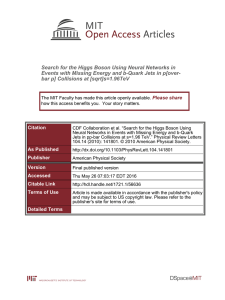

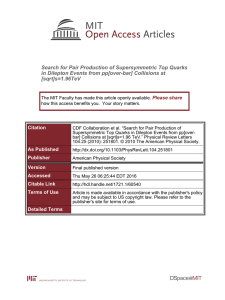
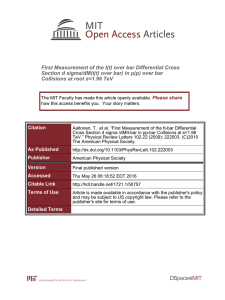
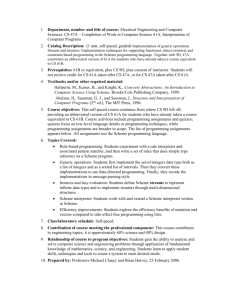
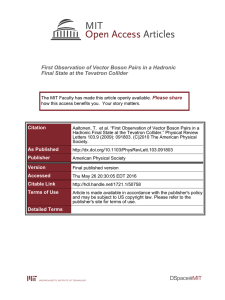

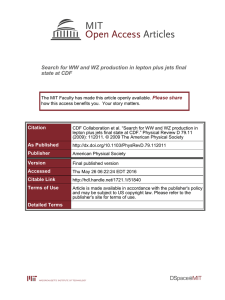
![First Observation of B[over-bar][subscript s][superscript 0]-->D[subscript s][superscript ±]K[superscript ] and](http://s2.studylib.net/store/data/012097029_1-f405f6f39639d76f6431ecbb2431142d-300x300.png)
